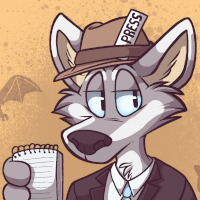Fledger by Nicholas Barrett, Book Review by Fred Patten
by Pup Matthias
Submitted by Fred Patten, Furry’s favorite historian and reviewer.
 Fledger: a Novel, by Nicholas Barrett.
Fledger: a Novel, by Nicholas Barrett.
NYC, Macmillan Publishing Co., September 1985, hardcover $13.95 (207 pages).
Ever since Adams’ Watership Down was published in 1972, just about any “realistic” nature fantasy centered upon one particular species has been “high profiled” as a “Watership Down for” (whatever species is featured). Fledger is certainly a Watership Down for puffins.
A flock of puffins is returning to Land (specifically a bleak, rocky shoreline) to dig burrows and lay eggs after three years of living at sea upon ice floes. Rock Samphire, a hen, is distraught and insulted because her mate, Sorrel, will not listen seriously to her dreams of impending disaster if they continue to build their rookery as puffins always have; on the Land and upon a small island just offshore. Ringleader, the flock leader, dismisses her dreams because the Golden Lord only sends true dreams to flock leaders like himself, and he has not had any nightmares. Rock Samphire stops protesting, but she builds a secret burrow for her egg on the other side of the island, apart from the other puffins. This just removes her from their protection, and she is eaten by the swaabies (great black-backed seagulls) just after laying their egg. Ringleader orders Sorrel to raise the chick, Goldie (Golden Samphire), in secrecy.
Goldie is predisposed from birth to believe in the puffins’ doctrine as revealed by Ringleader:
“‘And you must be Ringleader, sir,’ chirped the little bird. [No, it’s Sandpiper.] ‘And you have come to give me the Faith that I shall need to leave this strange burrow on the day when the Golden Lord calls me and the other fledger puffins down to the sea together to swim away from the Land.” (p. 33) Read the rest of this entry »




 GeneStorm. Book 2, Fort Dandelion, by Paul Kidd
GeneStorm. Book 2, Fort Dandelion, by Paul Kidd




 The Wind in the Willows, by Kenneth Grahame. Frontispiece by Graham Robertson.
The Wind in the Willows, by Kenneth Grahame. Frontispiece by Graham Robertson.